Mutton Pulao (Goat/Lamb Pulao)
A classic Mutton Pulao, Yakhni and all, made so easy-to-follow that you can’t possibly mess it up. This recipe promises deep flavor, tender goat or lamb meat, and fluffy rice. It’s also is designed to double so you can serve it to guests with confidence. Tested to perfection!
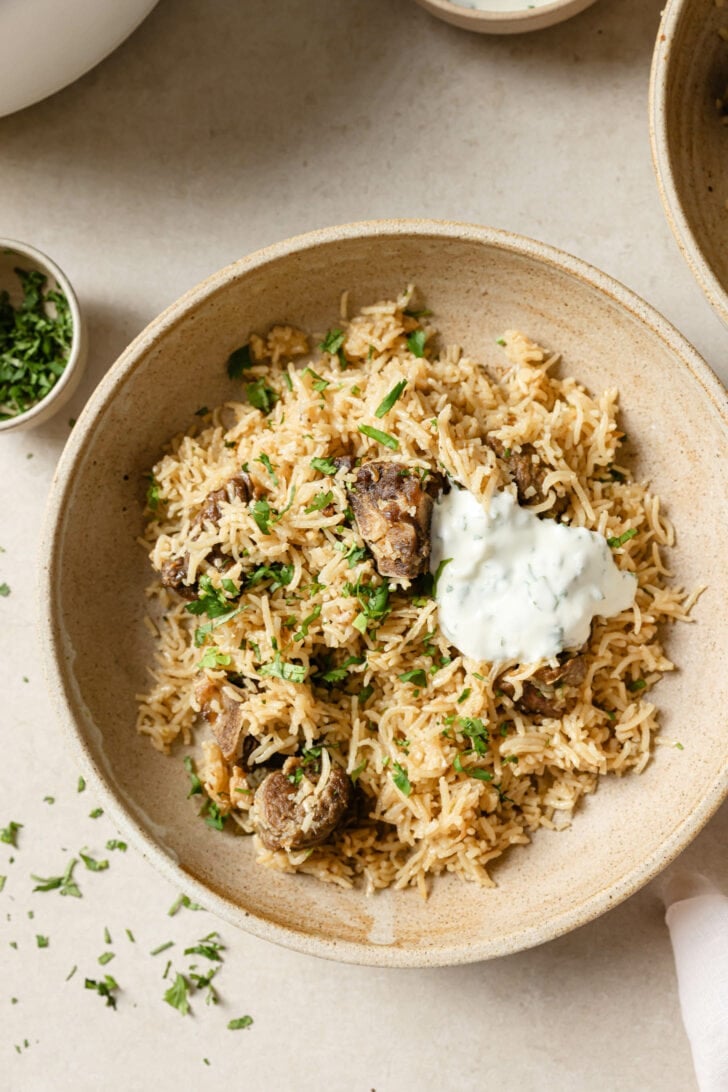
Want to save this post?
Enter your email below and get it sent straight to your inbox. Plus, get recipes & tips every week!
Mutton Pulao
Out of all the rice dishes in my repertoire, Mutton Pulao hits closest to home. It’s a Punjabi classic, an heirloom recipe. The one that reminds you of mom’s kitchen and connects you to the warmth of traditional cooking. I turn to it when I need a guest-friendly, low-effort (trust me!) main dish. Especially perfect for Eid!
Did you know? (From data gathered from my survey about Chicken Pulao)
- 55.6% of the surveyed audience found getting the rice right the trickiest part of making pulao.
- 37% thought getting the taste right was the trickiest aspect.
- And, much to my dismay, a whooping 69.5% prefer their pulao without tomatoes.🥲
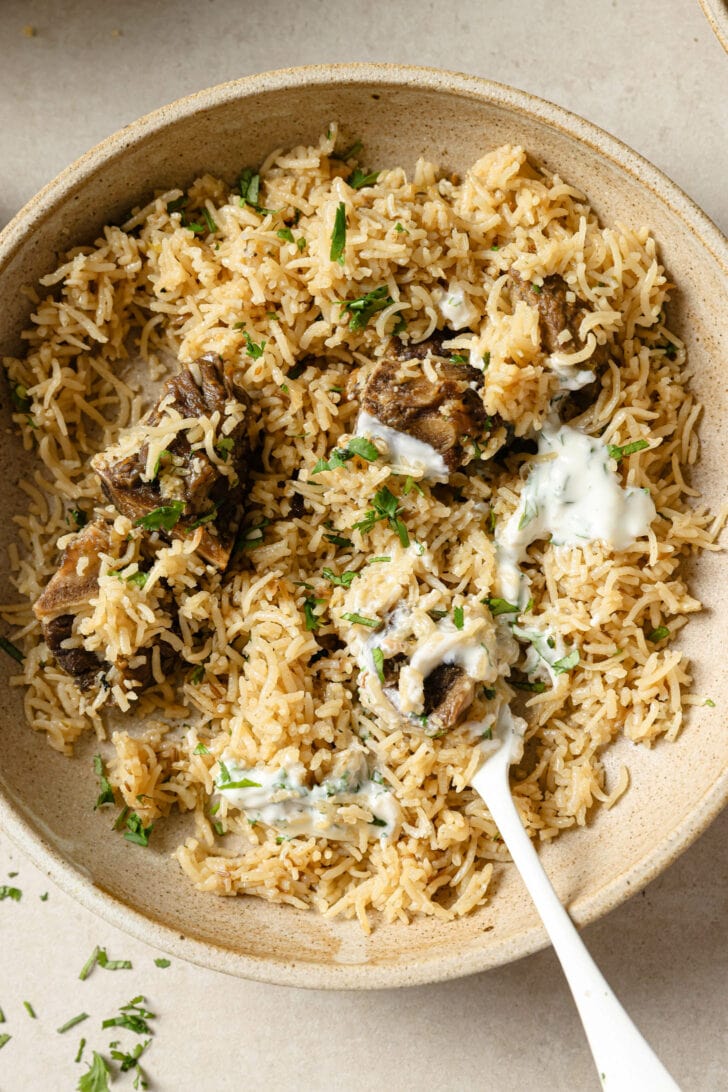
The Most Important Tip for Mutton Pulao
Have you ever had Mutton Pulao with chewy or tough meat? It’s usually not the age/type of meat that’s at fault. Often, the meat just wasn’t cooked long enough.
Here’s the key: Cook your meat on the lowest heat for 2 hours, or until it’s melt-in-your-mouth tender. If you’re confused about meat doneness, take a bite. If it’s at all chewy, cook longer. In the case of goat/lamb meat, falling off the bone tender is always better than leathery tough.
Remember – it’s hard to overcook goat or lamb meat. The worst that can happen is that your meat will fall off the bone in your pulao, which no one really minds. (At least I don’t. My mom’s pulao is always ‘over-cooked’, with morsels of tender meat scattered amongst the rice.) All this is to say – leave no doubt, cook it longer!
Love pulao? You’re in the right place. Don’t miss my Yakhni Chicken Pulao, Instant Pot Chicken Pulao, Matar Pulao, and Chana Pulao.
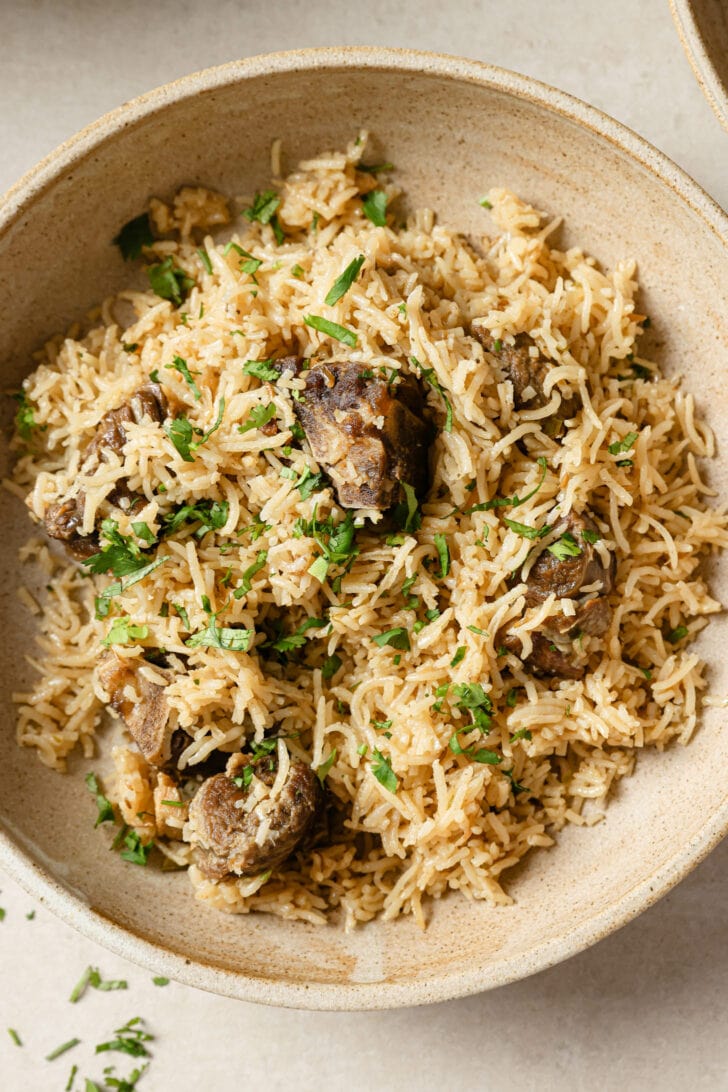
Ingredients
Yakhni (Broth Ingredients)
- Whole spices: You’ll need coriander seeds, cumin seeds, black peppercorns, cinnamon, green cardamom, black cardamom, bay leaves, and cloves. The ratio of the whole spices is balanced so that no one spice is detectable in the final broth. But as always, if you’re missing a spice or two, omit & proceed!
- Mutton (Goat or Lamb Meat): Usually pulao has medium-sized, bone-in pieces (~1.5″) of meat. You can use goat leg (more meat – less fat), goat shoulder (more meat – more fat), or mixed goat (includes some smaller sized, less meaty pieces). Increase to 1.25 lb meat if you like heavier meat to rice ratio.
- To make Beef Pulao: Replace goat/lamb with beef, but simmer for a minimum of 3 hours instead of 2.
- Onion: I’ve used yellow onion here but red onion works just as well.
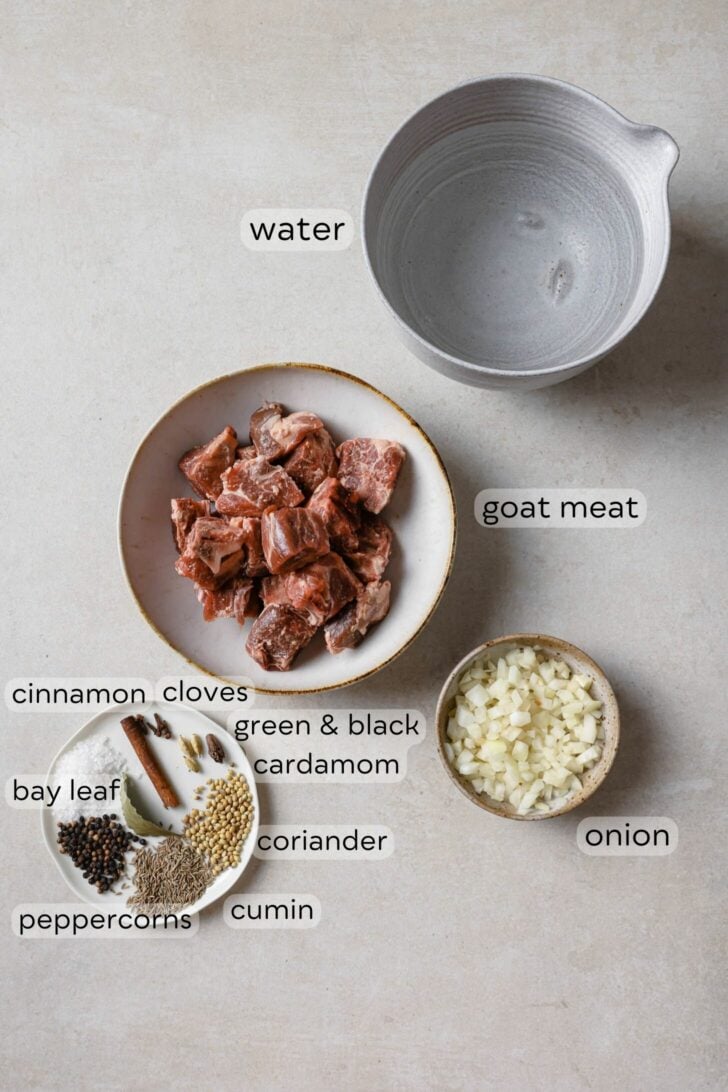
Fun Fact: In Pakistan and India, mutton usually refers to goat meat. Here in America, mutton means older lamb meat. Goat meat isn’t as popular here (I can only find it in halal meat stores), so you’ll often see mutton dishes made with lamb and even beef.
Mutton Pulao Ingredients
- Ghee/butter & oil: As usual, I love blending both for a balance of flavor and fluidity.
- Plain, whole-milk yogurt: Whisked, room temperature yogurt is the way to go to prevent curdling, but you’ll be fine even if you plop it in cold. It’ll eventually meld in with the broth and rice.
- To keep it dairy-free, omit yogurt and replace with one small (~100g) finely chopped Roma tomato.
- Aged, long-grain basmati rice: I use Royal’s Chef’s Secret, aged, long-grain basmati rice, which is tougher and is more resilient to excess liquid than other types of rice. That said, any rice will work as long as it’s aged, long-grained rice.
- More whole spices: Though the stock is infused with the flavors of the whole spices, I still find them essential within the rice. 1 – Blooming them in oil brings out a different element of their flavor and 2 – Whole spices in rice dishes make them festive and complete.
- If you’d rather not have any whole spices in the pulao, feel free to add more spices to the stock and/or substitute with 1/4 tsp ground garam masala while making the pulao.
- Green chili peppers: Gives a subtle kick of heat. I use 2 Thai chili peppers or 1 serrano but adjust as you’d like.
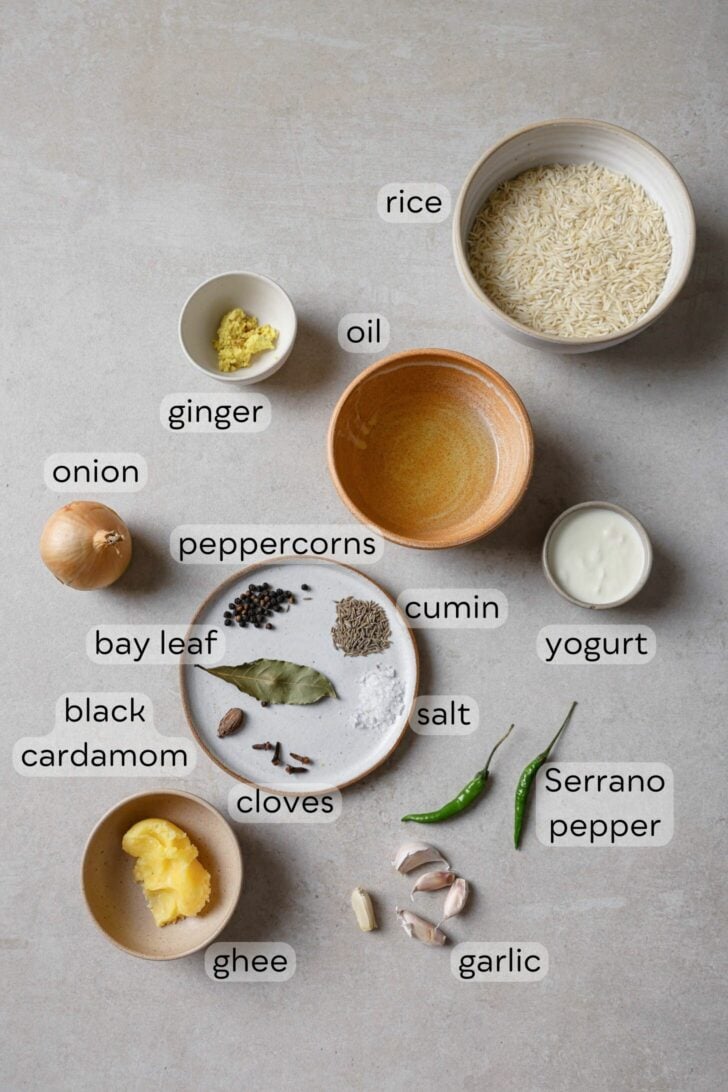
How to make Mutton Pulao – 3 Steps
Mutton Pulao is a passive, rustic recipe. It requires a bit of negligent patience, if you will. Try not to wait around for the mutton to cook, that can be frustrating. Here’s the play-by-play:
Step 1: Make the Yakhni (Broth)
- For tender mutton with maximum flavor, you want to ensure it cooks in the gentlest heat possible. Longer cook time = better tasting broth.
- To prevent the mutton from breaking while it’s sautéing (“bhunai“), make sure it’s just cooked but not completely falling off the bone.
- Worth repeating: In the case of goat/lamb meat, falling off the bone tender is always better than chewy or tough.
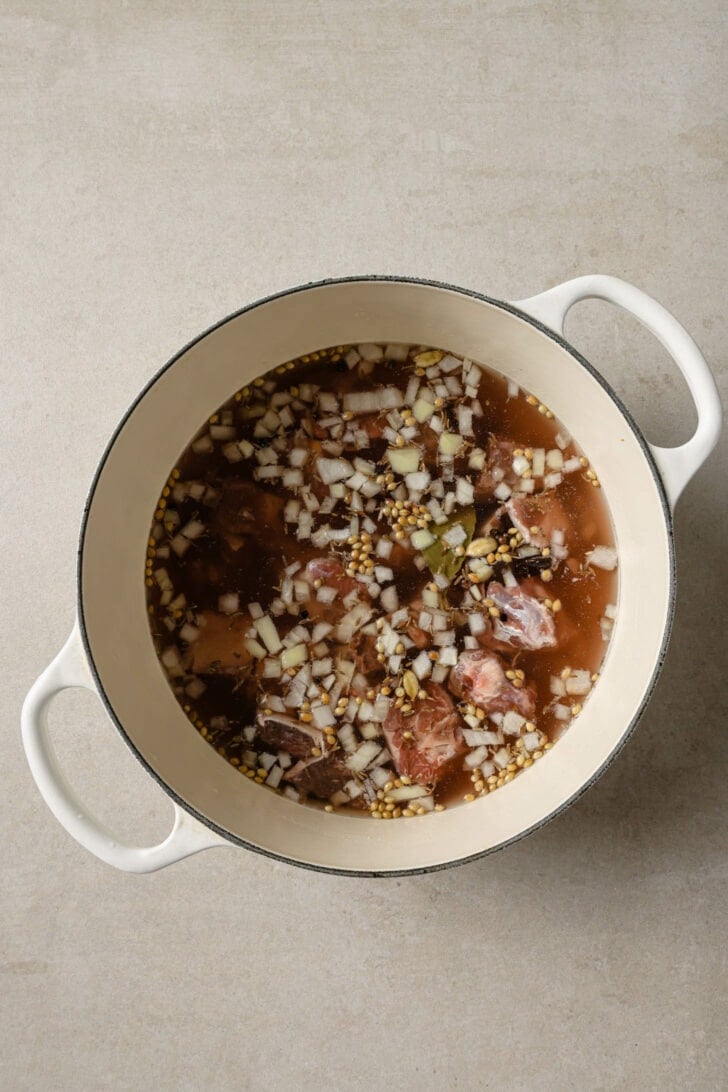
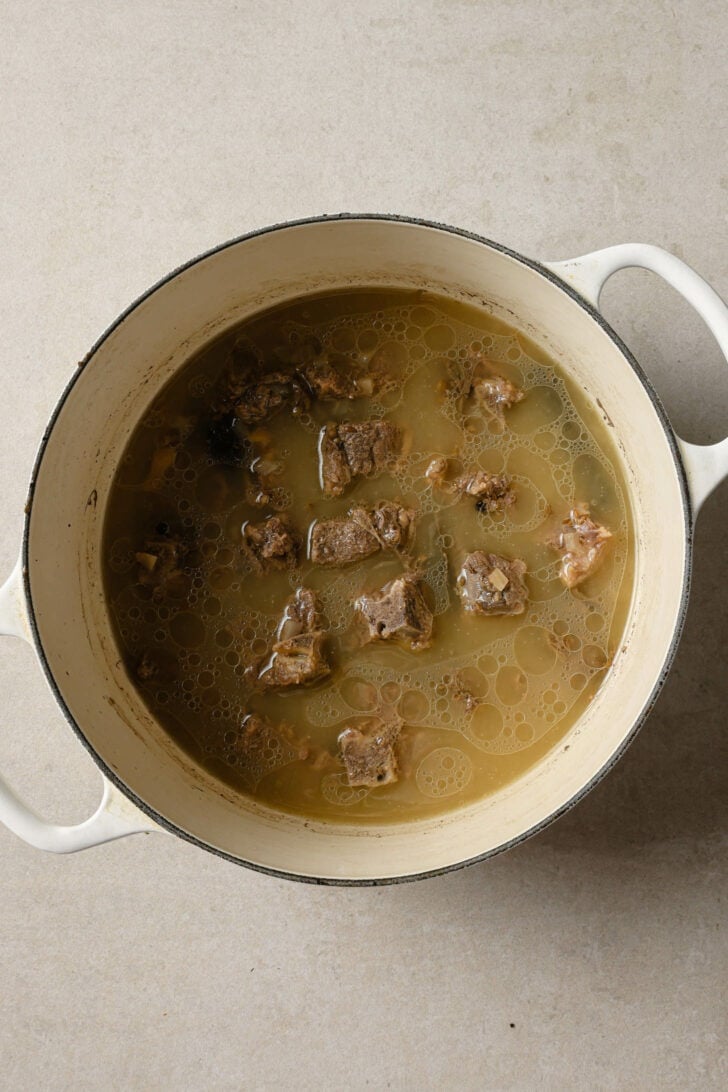
- Use a tong or slotted spoon to remove the meat from the stock, then strain the stock. Discard the remaining spices and onion.
- Next, measure the broth and add water (or reduce broth) as needed to make 2 3/4 cups.
Tip: Exactly how much broth you’re left with depends on the heat of your stovetop and the pot you use. To test this, I cooked the same stock over the same heat in 2 different pots, side by side. Starting with 3 ¾ cups water, one pot had 3 cups broth left over, while the other had 2 ¾ cups. Cook on the lowest setting so the least amount of water evaporates.
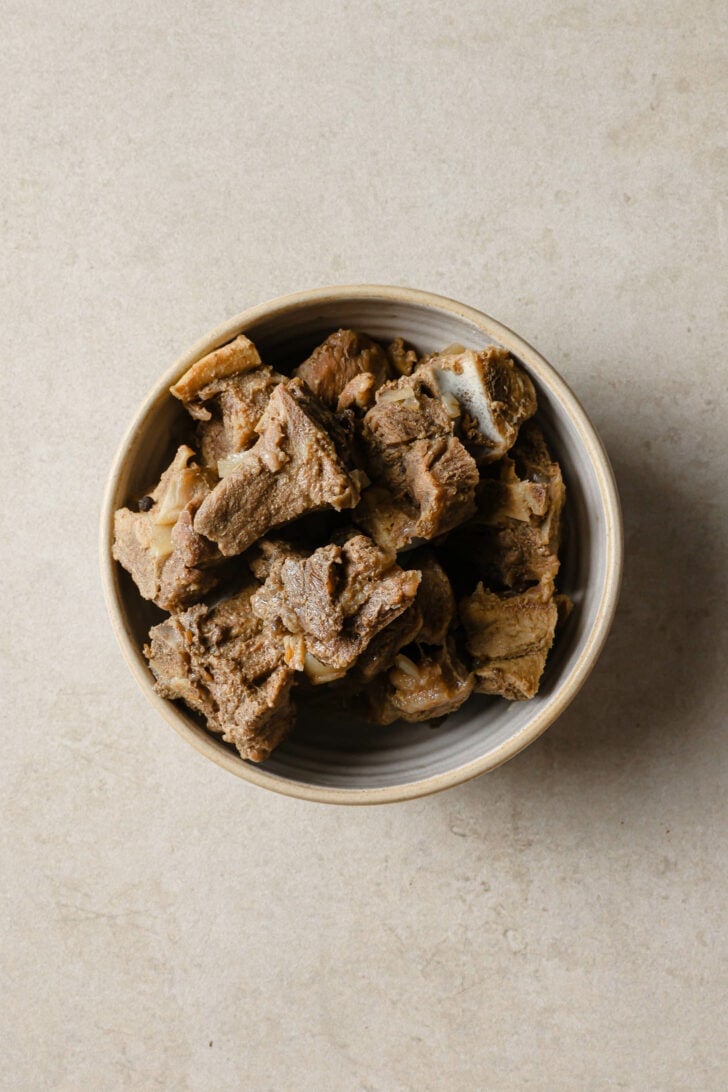
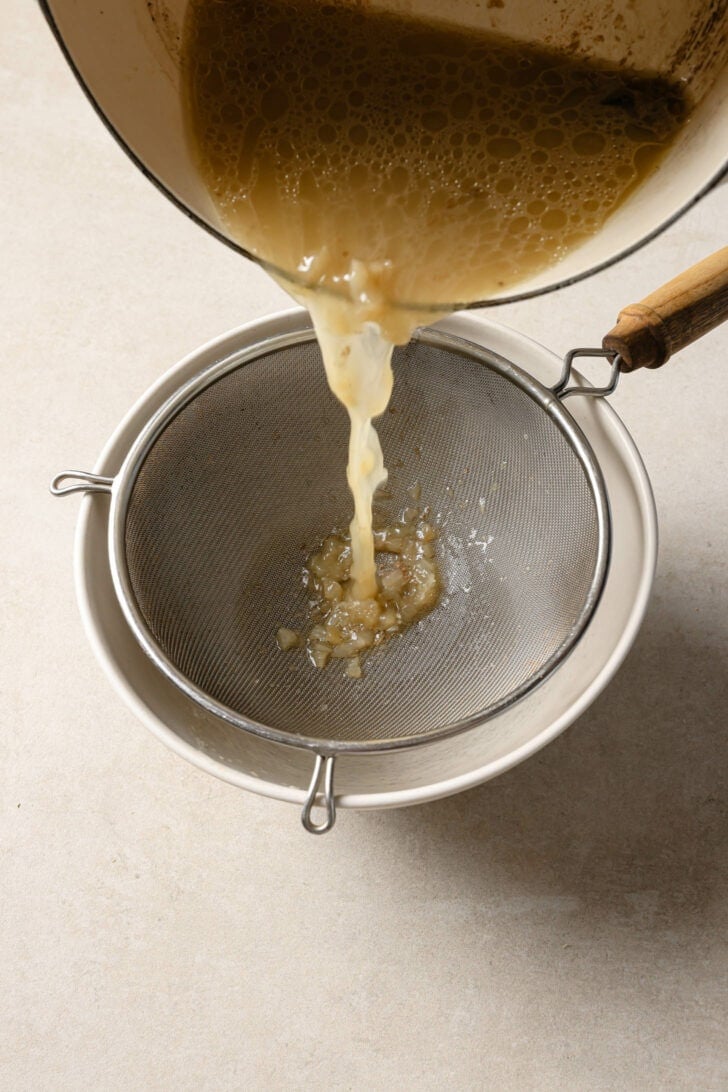
Step 2: Make the Base
- In all pulaos, the onions will determine the color of your rice. It’s important to be patient with them, stir frequently, and deglaze the pan to help them brown evenly. You also don’t want to brown them too much before adding the garlic and ginger because they’ll continue to brown until you add the meat and yogurt.
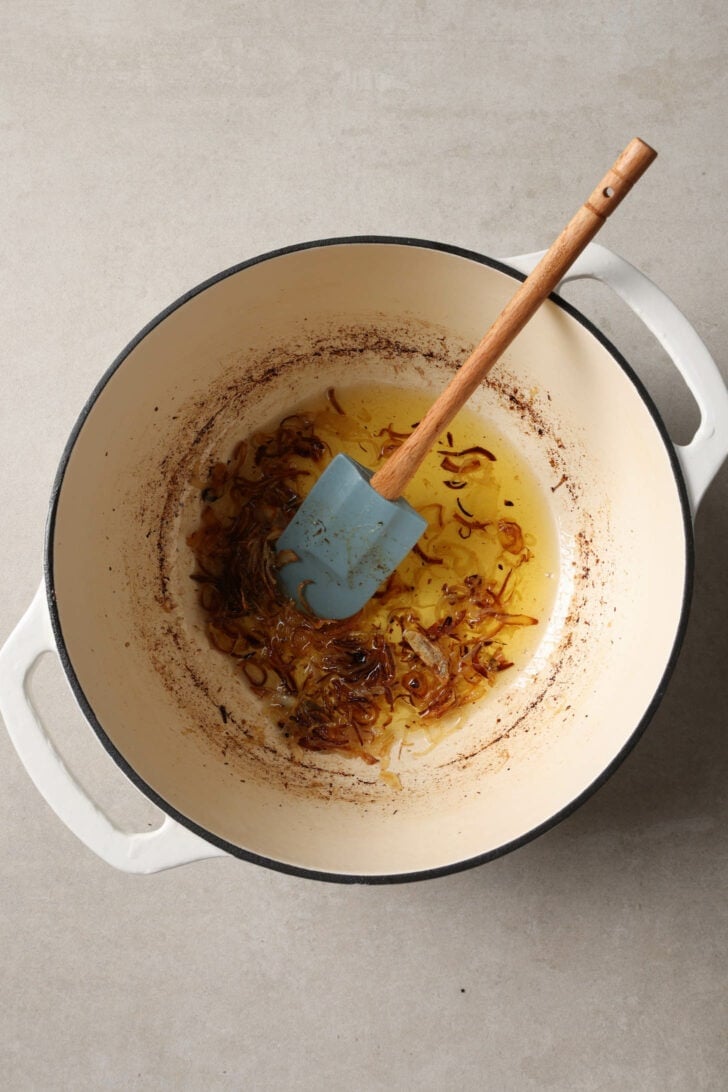
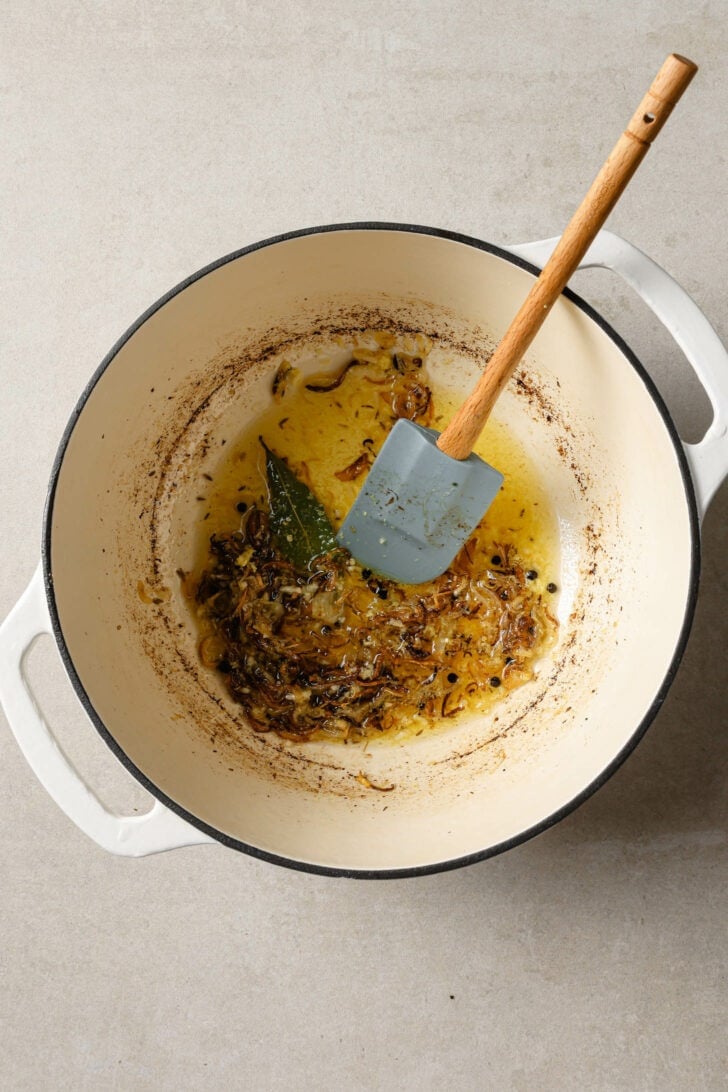
- Sauté the goat meat to take it from pale and dull to nice and seared, but not too long or it’ll darken.
- Stir in the yogurt and green chili peppers and sauté gently so the meat doesn’t break. Once the oil starts to separate, you’re ready to add the broth.
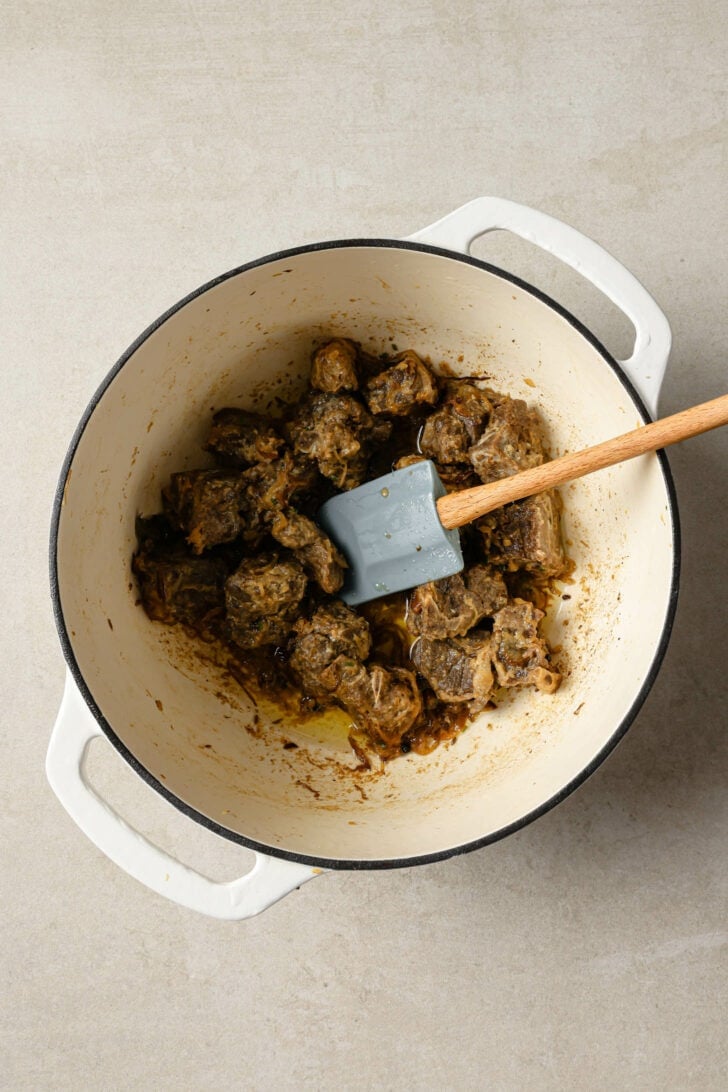
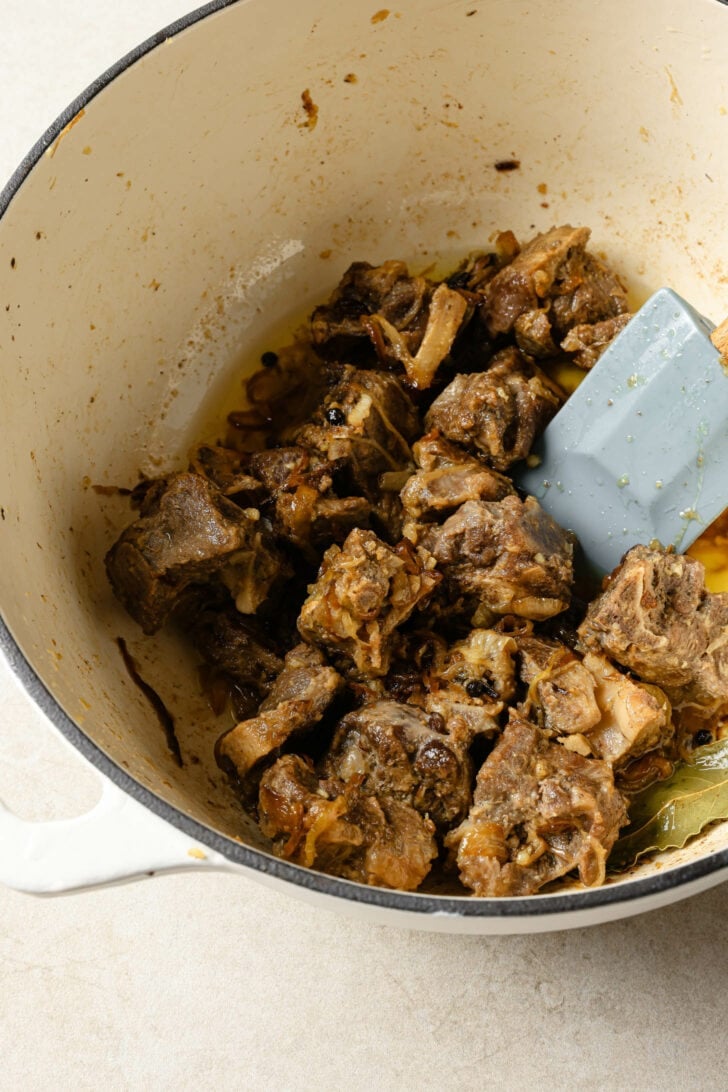
- Add the broth and bring to a boil. Then drain the rice well so you’re not adding any excess water.
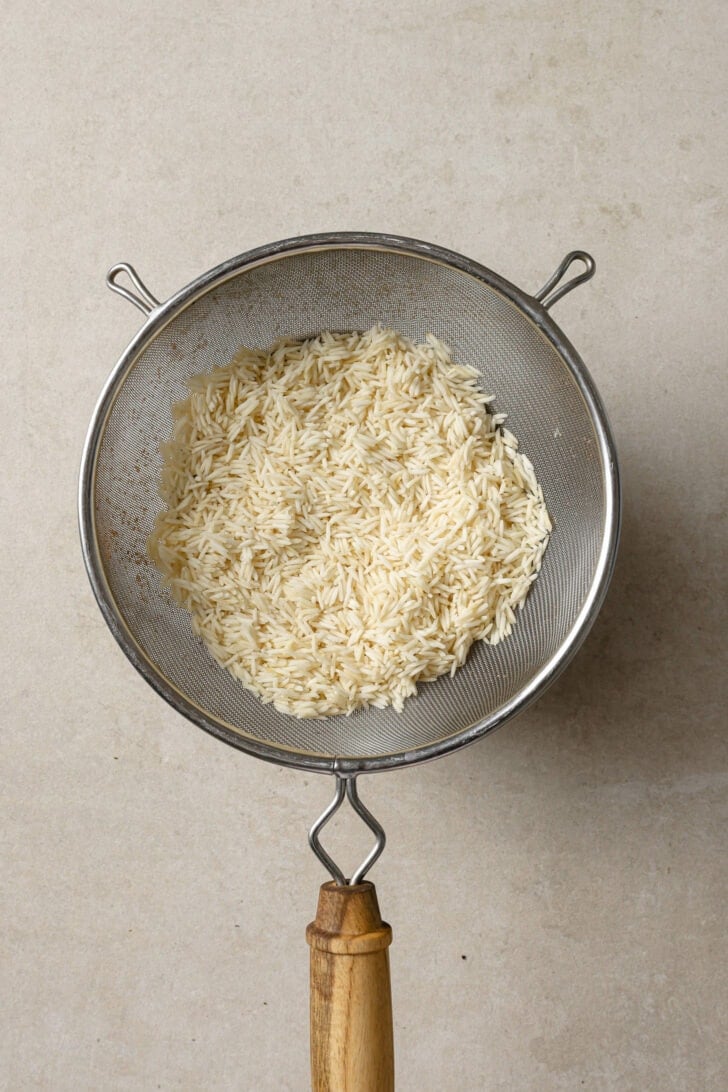
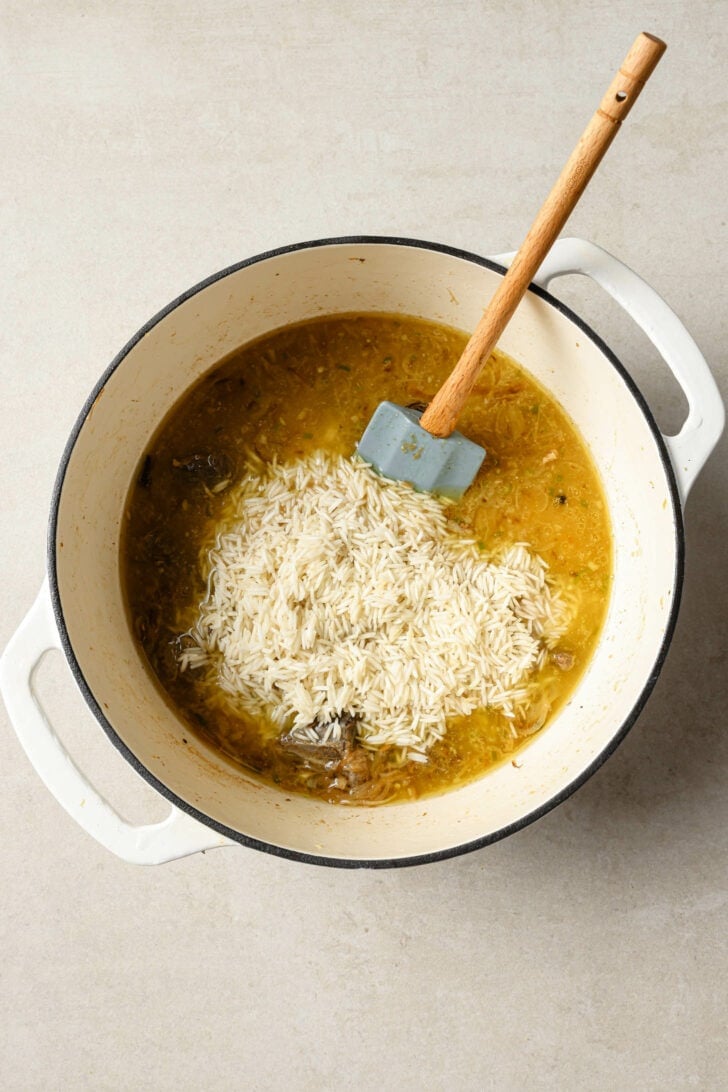
Step 3: Cook the Rice – Perfectly!
To start, you want to ensure basic rice essentials such as gently washing the rice until the water runs clear and soaking according to the recipe. As for the pot, I’ve found a non-stick Dutch oven (5.5 quart) to be the best at preventing the rice from sticking to the bottom. Once all this is in place, here are a few tips to ensure perfect rice, every time.
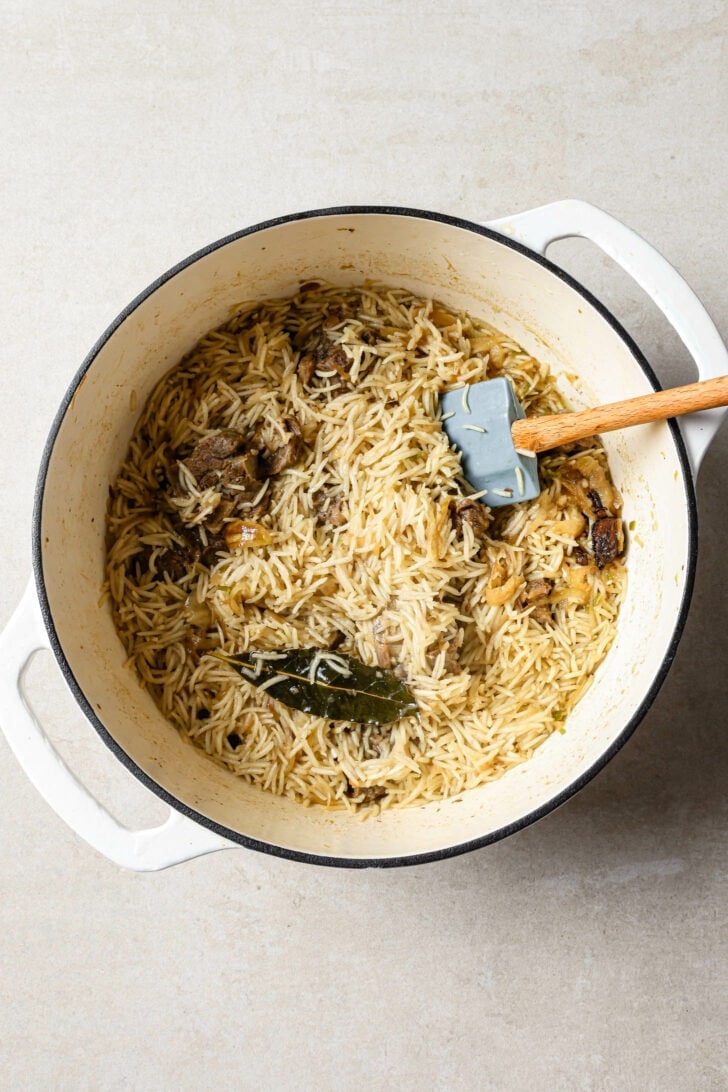
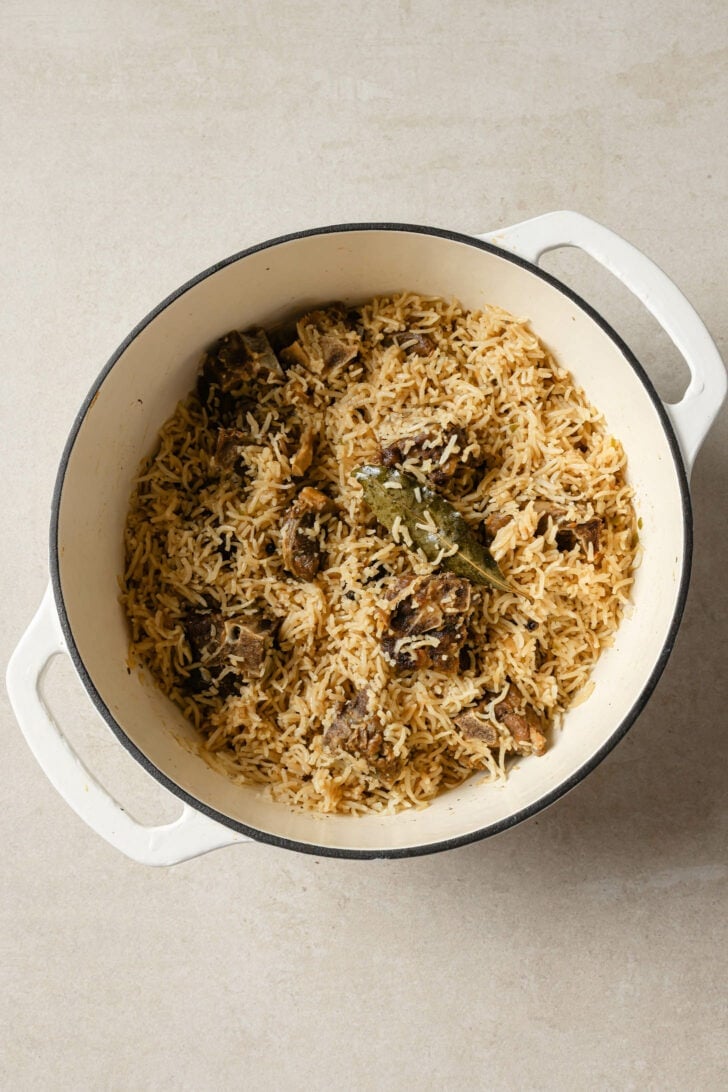
Know Your Rice
- Rice to water ratio: Aged basmati rice requires at least 1.5 cups of water per 1 cup of rice. (Most of my readers report using 1.5 to 2 cups of water per cup of rice). My ratios work well for aged, long-grain basmati rice.
- If your rice is less aged or prone to get mushy, use your usual ratio. So if you normally use 1.5 cups of water per 1 cup of rice, I use 2 1/4 cup broth for 1.5 cups of rice.
Bring to a Simmer
Pulao is generally made by simmering the rice until most of the water has absorbed or evaporated, and then turning the heat down for a final steam, or dum.
- Avoid stirring: After adding the rice to the boiling water, give it a gentle stir. And then leave it be. If you’ve ever cooked rice in a rice cooker, you’ll notice that it cooks rice from raw to fluffy without any intervention. Stirring runs the risk of breaking the rice kernels and interfering with the buildup of heat.
- Simmer, don’t boil: The key here is to keep the heat on medium or medium-high so that it simmers, but doesn’t aggressively boil. This gives the long grains time to soak up the liquid as it cooks off.
- To cover or not to cover: I’ve tried letting the rice simmer uncovered, partially covered, and fully covered. My happy medium (i.e. the least likely to mess with the water/rice ratio) is when the lid is partially covered.
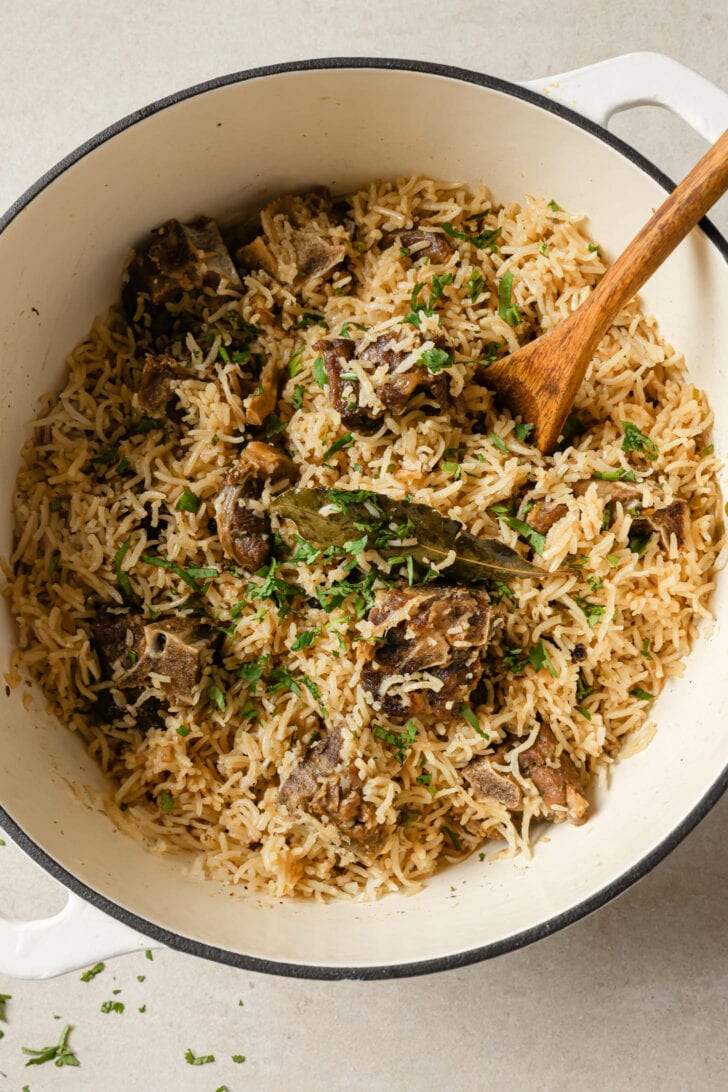
How to Steam aka ‘Dum’
- How to know it’s ready to steam: When most of the water from the surface has absorbed or evaporated and you begin to see something like potholes forming in the top layer of the rice (see video!), it’s ready for a final steam.
- Cover the underside of your lid with a cloth: I use old kitchen linens or a cotton cloth. The goal is to contain the steam while absorbing any extra moisture that could otherwise lead to soggy rice.
Troubleshooting
- Too much moisture before steaming:
- Allow water to evaporate. Simmer longer.
- Steam (dum) for a shorter time to avoid breakage.
- Rice dry before steaming:
- Sprinkle ¼ cup of water all over the top of the rice before the steam.
- When covering the pot for steaming, use a damp kitchen cloth instead of dry to give extra moisture.
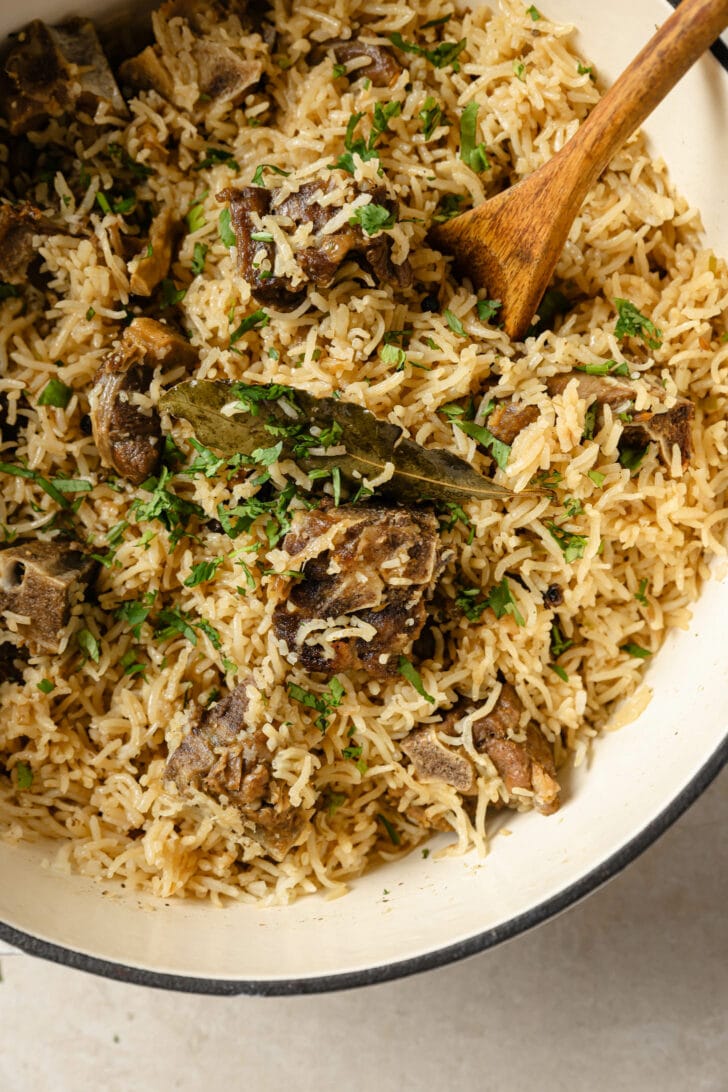
Let it Rest
- Let it rest even after steaming: Keep the lid on even after you’ve turned off the heat. This final rest is crucial. It allows the rice to settle into perfection and can cover any prior misgivings.
- Don’t stir even after cooking: The only reason to stir cooked rice is because resting the rice too long can make it clumpy or stick to the bottom. Use a rice paddle (not a fork) to fluff, but stirring, especially with a fork, increases the risk of breaking the rice kernels.
- Lastly, relax: Remember, if you’ve given your rice enough time to cook, even if you steam a little too soon or a little too late, you’ll be fine. There’s plenty of room for error with the steaming with cloth + resting method.
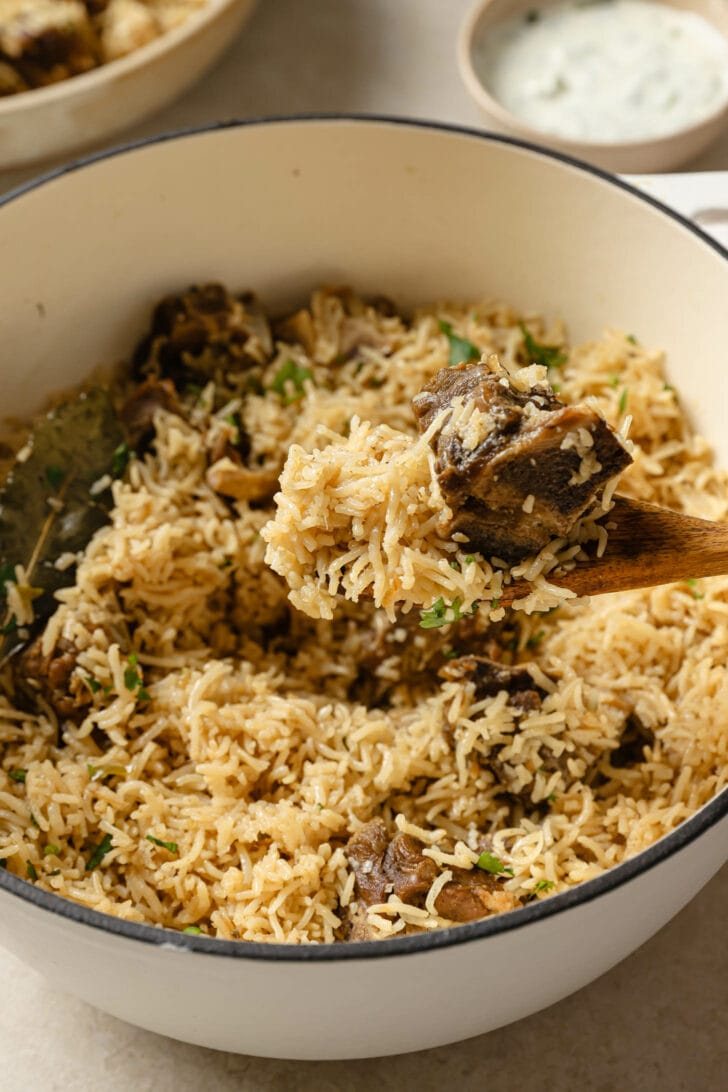
How to Double the Recipe
It just makes sense to double such an elaborate rice dish, and a double quantity is perfect to feed a crowd (8-12 people). Here’s how to do it:
- For the stock: Double all the ingredients except water. Using double the amount of water will likely yield excess stock, and therefore less flavor. Use 7 cups to make the stocks, which will yield around 5.5 cups stock (required for double the rice).
- Use a larger pot (8-10.5 qt).
- Increase the sauté and simmer times by 2-3 minutes.
Make-ahead option: You can make the broth in advance, cover, and store in the fridge for up to 48 hours. Bonus: It’ll deepen the flavors! Some fat will accumulate on top, no need to get rid of it. Allow to come to close to room temperature before using.
What to Serve with Mutton Pulao
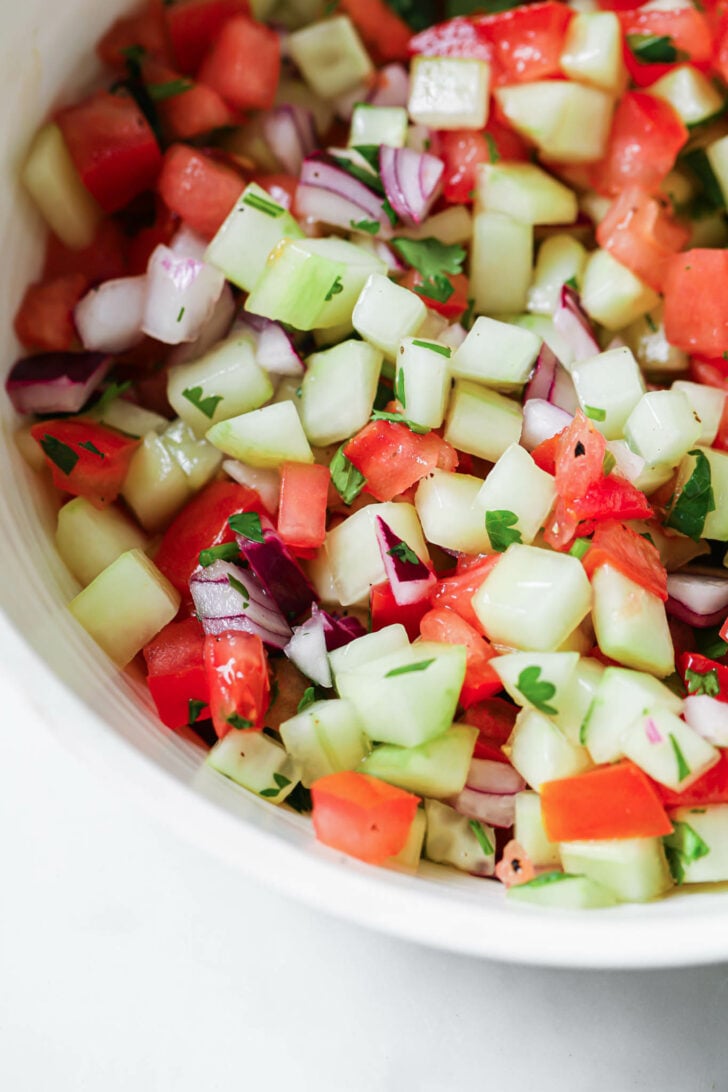
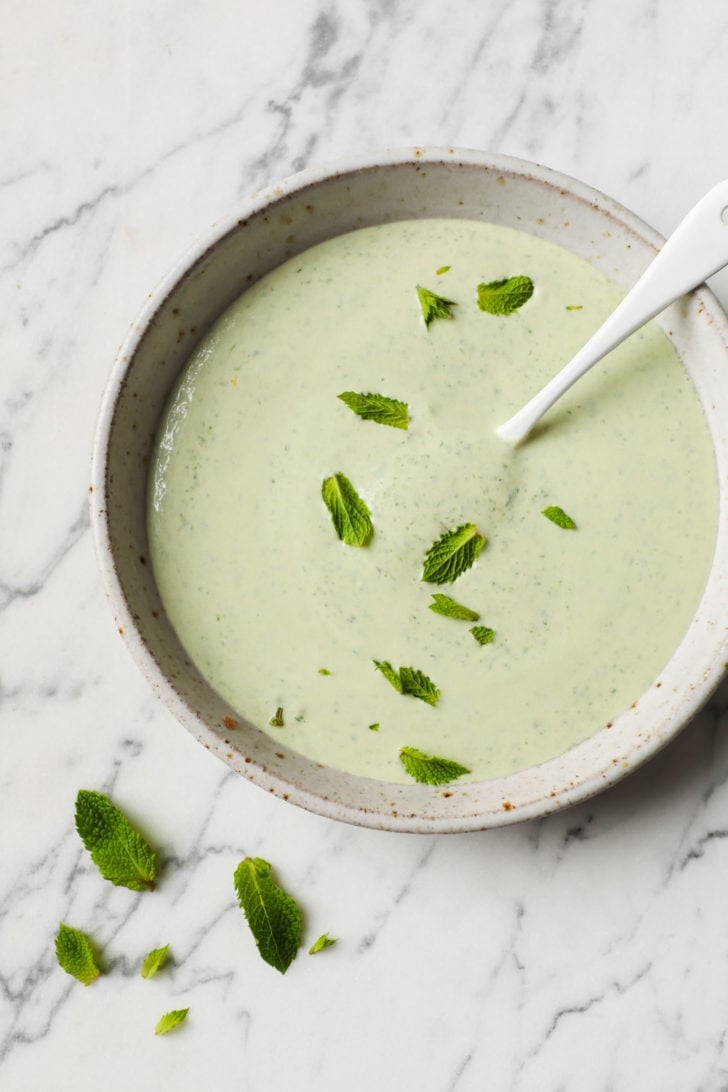
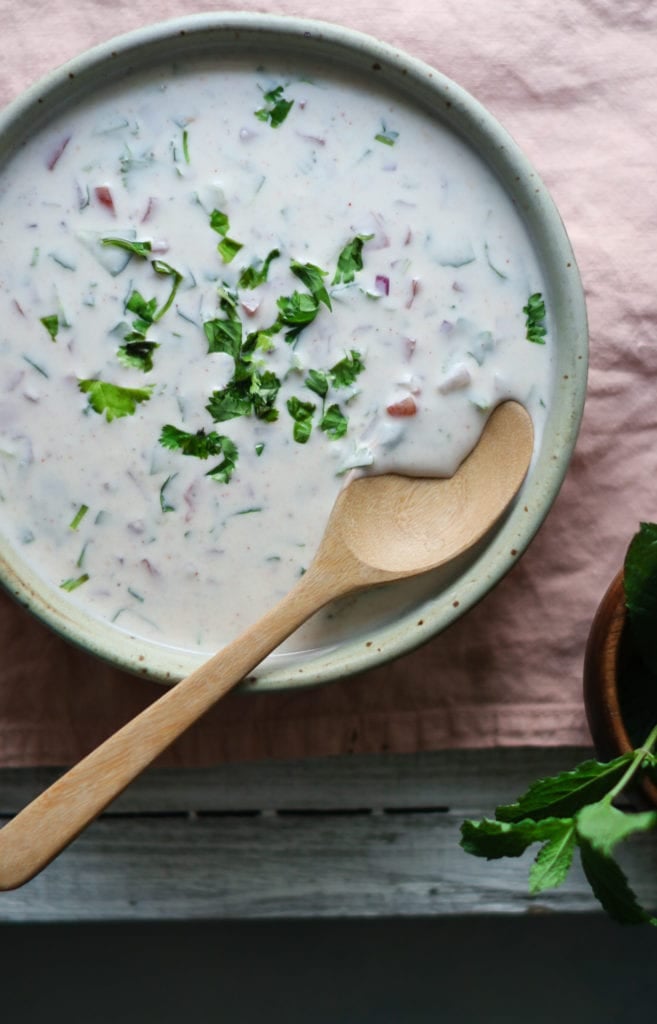
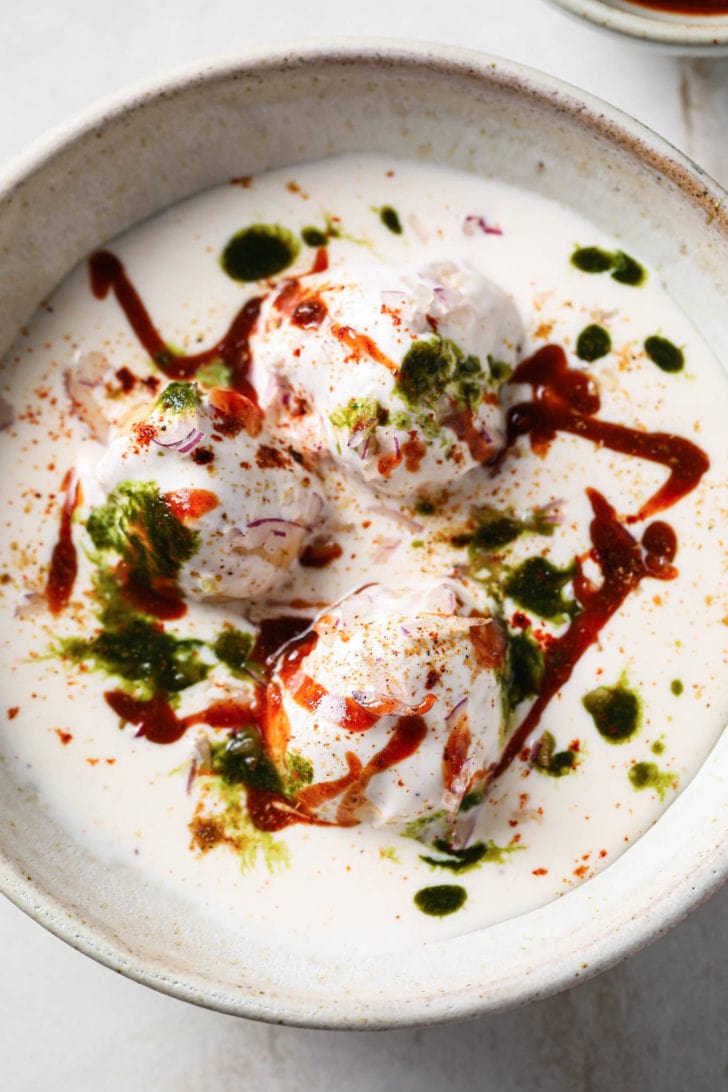
- For me, the only essential side is a cooling bowl of cucumber raita, mint raita, or plain yogurt. Dahi Bhalle would also pair well if serving to guests.
- To add freshness & crunch, try Kachumber Salad, or fresh, crunchy vegetables chopped up with a bit of salt, pepper, and lemon juice.
What Goes Well with Mutton Pulao
- Often, pulaos are accompanied with kebabs such as Chapli Kabab, Aloo ki Tikki, Shami Kabab, or Seekh Kebab.
- For parties, you can bulk up the spread with traditional dishes such as Chicken Korma, Chicken Salan, or Kofta Curry.
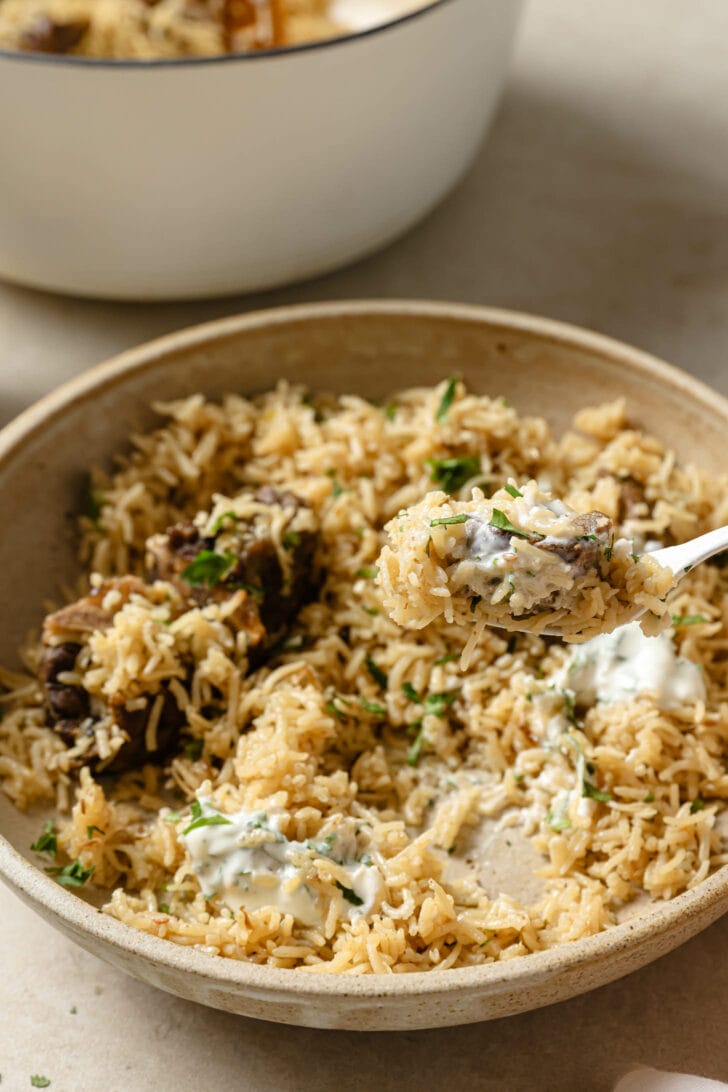
Tried this recipe? If you have a minute, please consider leaving a comment and/or a photo and telling me how it was! If you’re on Instagram, please tag me so I can see your creations. I truly love hearing from you. Thank you!
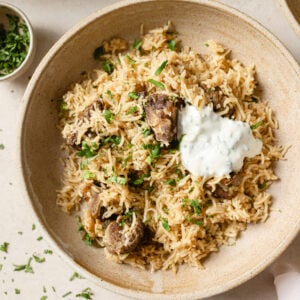
Mutton Pulao (Goat/Lamb Pulao)
Watch the Video
Ingredients
Broth (Yakhni)
- 3 3/4 cups water, if doubling recipe, use 7 cups water
- 1 lb (~454 g) bone-in goat or lamb meat (See Note 1), cut up into ~2" pieces, cleaned and excess fat removed
- 1/2 small (~80 g) yellow onion, roughly chopped
- 1/2 tbsp cumin seeds
- 1/2 tbsp coriander seeds
- 1/2 tbsp black peppercorns
- 1 2-inch cinnamon stick, both Cassia & Ceylon are fine
- 1 medium dried bay leaf
- 3 green cardamom pods, slightly cracked open
- 1 black cardamom
- 4 whole cloves
- 2 tsp kosher salt
For the Pulao
- 1 1/2 cups (~275 g ) aged, long-grain basmati rice
- 1/4 cup neutral oil, such as grapeseed oil
- 2 tbsp unsalted butter or ghee
- 1 (~150-170 g) medium yellow onion, quartered and thinly sliced
- 1 medium dried bay leaf
- 3/4 tsp cumin seeds
- 1/2 tsp whole black peppercorns
- 4 whole cloves
- 1 black cardamom
- 5 garlic cloves, crushed or very finely chopped
- 3/4 inch fresh ginger, crushed or very finely chopped
- 1/2 tsp kosher salt
- 1 medium Serrano pepper, sub 2 Thai bird’s eye green chili peppers
- 2 tbsp plain, whole-milk yogurt, whisked
Garnish – After Steaming (‘Dum’)
- 3 tbsp cilantro leaves, finely chopped
- 1 tbsp mint leaves, finely chopped (optional)
Equipment
- Dutch Oven (5.5 qt) (nonstick or heavy-bottomed)
Instructions
Make the Broth (Yakhni)
- Place a stock pot or lightweight Dutch oven over medium-high heat. Add all of the ingredients listed under ‘Broth (Yakhni)’ and stir to mix. The water should cover most of the meat. Cover to bring to a boil. If needed, use a slotted spoon to remove any large scum that rises to the surface.
- Reduce the heat to low so that it simmers gently. Cover and allow to cook for 1 hour and 45 minutes, up to 2 hours, until the meat breaks easily when pressed with a wooden spoon. It should be very tender, almost falling off the bone. Turn off the heat.
- Use a tong or slotted spoon to separate the meat from the broth. Cover the meat and set it aside. Place a bowl under a strainer and strain the onion & spices from the broth (yakhni). Discard excess onion and whole spices. Measure out the liquid; it should come to around 2 3/4 cups – See Note 2. If not, add water to make it 2 3/4 cups.
Prepare Mutton Pulao
- Wash rice: When ready to prepare the pulao, thoroughly wash the rice until the water runs clear. Then soak it in water. Set aside.
- Heat oil and butter/ghee in a nonstick Dutch oven over medium heat. Add the onions and sauté, stirring often, until golden brown (~10 minutes). The onions will determine the color of the pulao so you want them deeply and evenly golden-brown. Deglaze the pan with ¼ cup water. Once the water dries up, add all the whole spices, garlic, and ginger and sauté for a minute or two, until aromatic.
- Raise the heat to medium-high. Add the meat and allow to lightly sear for 2-3 minutes, stirring occasionally so not to break it.
- Stir in the salt, green chili peppers, and yogurt and gently sauté until oil starts to separate, another 2-3 minutes.
- Add broth and give it a taste. It should taste saltier than you prefer because it’ll mellow out once rice is added. Bring to a boil.
- Meanwhile, drain the rice thoroughly. Once the broth comes to a boil, add the drained rice and stir gently to mix. Bring to a boil again.
- Once the rice comes to a boil again, reduce the heat to medium. Cover partially with the lid. Allow to simmer, undisturbed, for 5 minutes. The water level will reduce as the rice absorbs it. You'll see what looks like potholes on the surface (see video).
Steaming (‘Dum’)
- Wrap a kitchen cloth underneath the lid and pull the cloth over the lid handle. This helps tightly seal the pan and contain the steam.
- Reduce the heat to the lowest setting, and allow to cook for 15 minutes. Turn off the heat and allow to rest for another 10-15 minutes. (Do not peek or stir throughout this process.)
- Sprinkle in cilantro and mint (if using). Keep covered until ready to serve. Use a rice paddle to transfer the rice onto a serving tray (or your plate!). Otherwise, stir gently to prevent any clumps. Serve with cucumber raita, mint raita, or plain yogurt.
Notes
- The general ratio is 1.5-2 cups water for every cup of basmati rice, depending on how new, aged, or long-grain it is. 1.5 cups of my rice (Royal Chef’s Secret extra-long) needs 3 cups to cook on the stovetop and rice cooker, but for this recipe I accommodate for the extra moisture from the other ingredients.
- If you cook rice often, go with your usual ratio. For example, if you normally use 1.5 cups of water per 1 cup of rice, use 2 1/4 cup water for 1.5 cups of rice.
- For doubling: Use 5.5 cups stock.


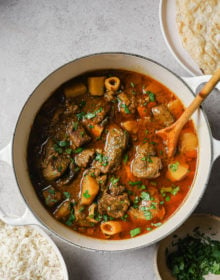
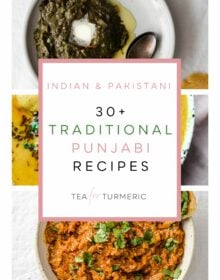

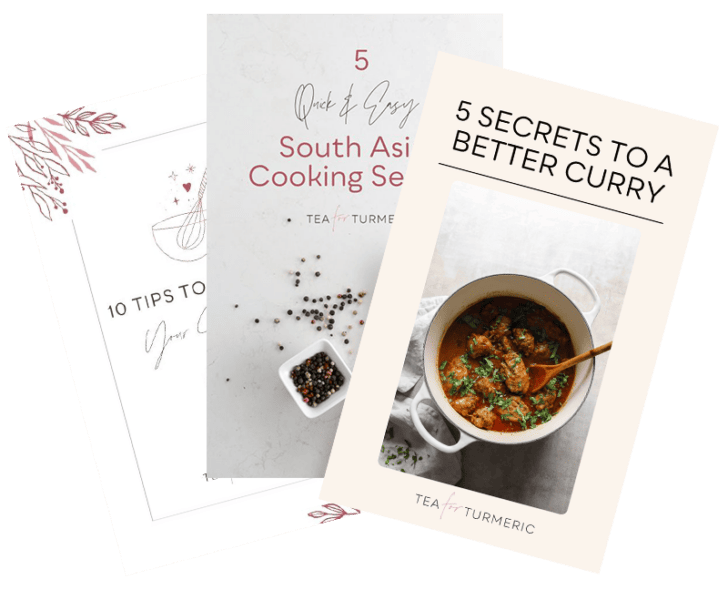
23 Comments on “Mutton Pulao (Goat/Lamb Pulao)”
This recipie SAVED me. I made It for an iftaar dinner for my in laws and got lots of compliments! Really appreciate the double serving noted because the ratios and seasonings were perfect. Thank you
That’s wonderful to hear! Happy to hear the Mutton Pulao was a hit 🙂 Thank you for sharing!
I’ve made this twice now, both doubled the recipie and both times I’m going through such an anxiety fit to what the outcome will be of the rice.. and both times its been perfect!! I cannot believe I can make rice!
Yay! That is so wonderful to hear…thank you for sharing 🙂